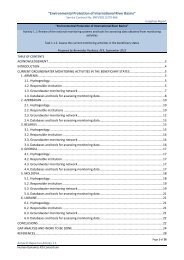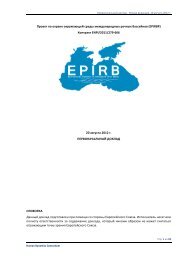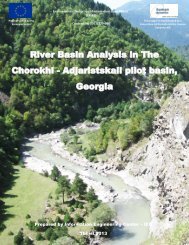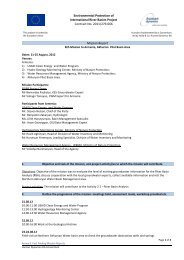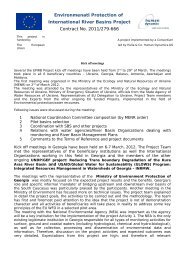Nokia Standard Document Template - Environmental Protection of ...
Nokia Standard Document Template - Environmental Protection of ...
Nokia Standard Document Template - Environmental Protection of ...
- No tags were found...
Create successful ePaper yourself
Turn your PDF publications into a flip-book with our unique Google optimized e-Paper software.
4th Mission Report _KE3_Jan –Feb 2013For the FS 45:i.) To ensure that the operational method is clear to all analysts, an SOP should be produced for theTime drive method.ii.) The Time drive method should be developed for specific hydro carbons such as crude oil, diesel oils& total petroleum products.The problems with the AAS in Batumi and Tbilisi are serious, as it means that the MoE cannot analyseheavy metals accurately in water. These instruments require immediate attention, but unfortunately theDepartment’s resources are limited. Therefore the Deputy Minister has submitted an <strong>of</strong>ficial letter to theproject to assist in resolving this problem to repair the AASs. This letter is in Appendix 11 and should bediscussed by the Project Senior Management to progress this urgent issue.For the Hydrobiological Analysis:During this year the two experts <strong>of</strong> BMI at the Centre could assist with the Georgian joint field survey.Samples could be taken in duplicate with one set <strong>of</strong> samples analysed at Tbilisi and the other set at theBatumi Centre.For Quality Control:Establish AQC standards at least for the nutrient parameters prior to the JFS.WB DelineationThe KE3 was unable to meet with other Key Experts to work together for the delineation <strong>of</strong> the waterbodies. However they did meet up the GIS experts and the other stakeholders and they will liaise with KE3to ensure the data for the water bodies at risk will be included.Summary & ConclusionsActivity 1.5The KE3 visited the three Caucus Countries providing intense training to the water analysis departmentsto ensure that they could establish and/or develop the own internal AQC systems. This training included aregional training workshop in Tbilisi and then supplemented by local customised workshops in eachcountry. Where appropriate this was also further supported by hands-on training <strong>of</strong> the staff using theirown analytical results.It is essential that most <strong>of</strong> these systems are established prior to the Joint Field Survey in June 2013.Most countries should have had sufficient training to undertake this challenge, however if necessary theKE3 could provide distance training and support prior to his next visit.Georgia has already established this system, but only for about five parameters and needs to develop thisfor more parameters. Azerbaijan already includes internal AQC’ s for a few parameters, but needs todevelop this to calculate the precision statistics and the Shewhart charts. Armenia has still to incorporatesuch a system, at least for the nutrient parameters.Outputs1) One regional training workshop with five PowerPoint presentations was submitted to 19 delegatesElectronic copies UK method validation s<strong>of</strong>tware (AQC99)was also submitted together with a demoversion <strong>of</strong> the Hydrobiological s<strong>of</strong>tware Aquabiobase.Page 17 <strong>of</strong> 36




